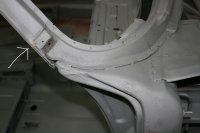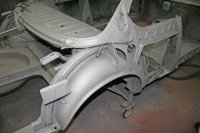I'm most familiar with the 3M products, 3M Automix Panel Bonding Adhesive - 08115 is one that is structural. But there are several that have extended work times and strengths. Any auto body supply shop will have the product.
New car repair, with new high carbon steel, isn't as thick,etc. so this type of repair was developed for some time now- well over 10 years.
Since there's no welding, there's no distortion- a big issue on a large panel. Since it's waterproof, there's that benefit. Just use a little common sense on the seams, so they are sealed well. Like I said, I would also add dynomat or fatman back behind a blind panel not only for the sound, but for the waterproofing properties to protect the seam only because I live near the coast and know what moisture can do.
Conversely, if the seam was visible like a wheel well panel, I would weld and hammer finish for an authentic look as possible.
I know from pictures that several E9 restorers use this procedure on floor pans ( Coupeking) and roofs ( Europe). If there was a situation where a good ground was required, say a battery box or pan in a Porsche, I would also spot weld enough areas for the electrical path.


